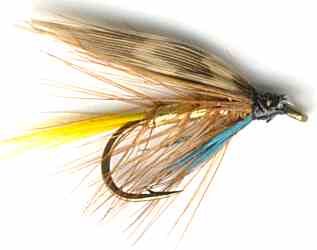Gold Invicta Caddis Sedge Wet Fly
The Gold Invicta Caddis Sedge Wet Fly is a great stillwater trout fishing fly pattern. It is a variation of the original highly successful Invicta fly pattern which was created by James Ogden in 1879 as an imitation of a dark Caddis.

CADDIS WET FLY PATTERNS. Hook size 10 12 14 - $US each
The Invicta is a good stillwater fly and also ideal for river fishing in high summer. I like using this fly as part of a team of three flies on droppers tied under a strike indicator or a large dry fly. The secret of loch fly fishing and other high altitude lake and reservoir angling is to know the peculiarities and physical layout of the water you are fishing. This means knowing where the most productive locations are to find fish regardless of the climatic conditions prevailing that day. Then you can fine tune your assessment of where to start fishing by factoring what effect the weather has had on the fish in those locations.
Rainbow and brown trout, like salmon, prefer shallower areas of a loch especially when they are feeding. They all move to deeper water to take refuge when they are disturbed or to take a respite from hot sunshine. In these deeper areas they do not feed as intensely. The experienced fly fishing angler will search along the banks, casting both far out and along the shore line where the depth varies from 3 to 8 feet. In the evening the shallows of 18 inches to 3 foot are a good place to search with a drifting team of flies. These shallow locations can often be found in bays, off headlands and around islands
Weed banks provide food and cover for trout. They search between the steams for aquatic insects, snails and freshwater shrimps. The bigger trout hunt for smaller bait fish. A cast and drag free dead drift of a team of flies parallel to and just outside the weedy area often brings rewards.
In my opinion the most promising are to fish is near an inlet. Trout like well oxygenated water and so do the insects like they feed upon. The stream that enters a body of Stillwater also brings with it a constant source of food washed down from the mountainside. They are particularly productive areas during time of spate after a heavy rain storm. The force of the stream is increased and it has power to dislodge stones and wash away more insects than normal. This is why you will find trout hanging around an inlet.
Outlets are also a good hunting ground for both the trout and the fly fisherman. The funneling effect of the water current concentrates the amount of available floating aquatic insects. The trout know this and lurk in the calmer water on the crease. This is where the faster flowing water that is about to exit the loch or lake meets the calmer water. The trout wait for a piece of food to pass in front of their eyes in the faster moving water before making the effort to grab it. This way they can save energy. Locating and fishing the creases is good fun.
CUSTOMER'S COMMENT
One afternoon last June I went boat fishing on Bewl Water. Using a drouge we slowly drifted, casting teams of flies before us to the fish waiting in the upper layers of the water. We had a few fish but we knew the real action would start after four o’clock when caddis hatch started.
Right on cue they started to come off the water. I tied one of your Gold Invicta wets on point. A Partridge and Yellow Soft hackle wet fly on middle dropper and a Godard’s Caddis on the surface. We drifted for a while and then anchored amid the hatch, in the shallows. I took one rainbow on the dry fly and six on the gold Invicta. I use a simple technique. I cast a long line which is retrieved fairly slowly and jerkily. As the droppers clear the water I dibble them in the water for a second. The dibbling part can lead to some exciting takes. The trout seem to wait until the last minute to take the fly. - Derek Robson, Leeds
FACEBOOK READER'S COMMENT
As far as I know the gold (and the silver) Invicta is a much later departure from Ogden's pattern which was simply the Invicta and is distinguished from the later versions by a yellow seals fur body. Still a great pattern for mayfly time and sedge pupa. - Trevor Greene
CUSTOMER'S COMMENT
Last June I was fishing Wick Green shore on the Chew Valley Lake. There was a mild westerly breeze and by 9.30 pm I was surrounded by a huge hatch of caddis. Fish that had been put out of my casting range came nearer in. I chose a gold Invicta on point to imitate a drowned or crippled caddis, I put an olive pupa caddis nymph on my middle dropper tied under an elk hair caddis. I retrieved the flies with steady foot pulls on a floating line and long leader. I had a strong take on the olive caddis pupa. This rainbow made a powerful run which took all my fly line and took me on to the backing. Then it ran towards me at speed. I had the utmost difficulty keeping in touch with it. I had to strip the line as fast as I could. I gradually got control and eventually netted a perfectly formed 4 lb rainbow trout. James Berry, Manchester

